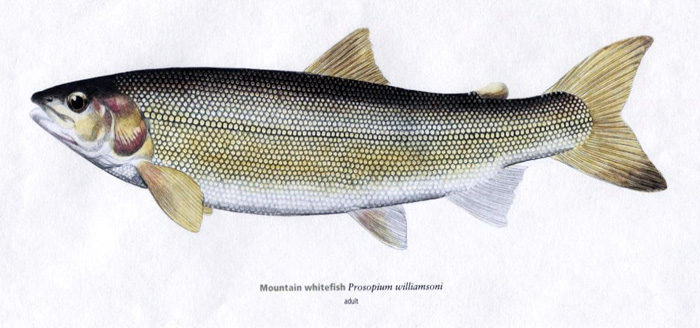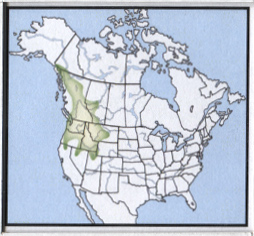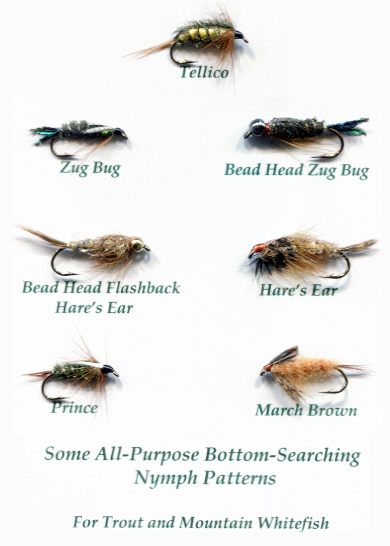Mountain Whitefish, March 2011, Fish of the Month!
 Mountain Whitefish
Mountain Whitefish
Prosopium williamsoni
Local Names:
Rocky Mountain whitefish, Williamson’s whitefish
Average Size:
8 to 12 inches
½ to ¾ lb.
Distinguishing Field Marks:
Trout-shaped body with adipose fin between dorsal and tail.
Relatively small head with a small mouth
Snout extends slightly beyond tip of lower jaw
Eyes are moderately large
Scales are of moderate size, with 74 to 90 along the lateral line.
The tail fin is moderately forked with pointed lobes
North American Range:
Map to the right shows approximate range in North America.
Diet:
The very young feed entirely on plankton, then, as they grow larger feed almost exclusively on immature aquatic insects. Both as juveniles and adults, Mountain whitefish will feed on the occasional crustacean, mollusk, or small forage fish.
 Fly Fishing for Mountain Whitefish:
Fly Fishing for Mountain Whitefish:
This is another of our North American freshwater species that probably no one will travel to find and fish for. It is, however, a fish that nymphing fly fishers prospecting for trout in northwestern streams will sometimes frequently encounter. Mountain whitefish prefer cold, often high altitude streams. As almost exclusively bottom feeders, they will readily take a variety of nymphs, especially those tied with bead heads. A few of the more popular patterns are illustrated below. Should you find whitefish becoming a nuisance, and want to avoid them in favor of trout, simply fish mid or top water flies instead of nymphs on bottom.
You’re most likely to find a whitefish on your hook while you’re casting 4, 5, or 6 weight fly rods for trout. Should you decide to target this species, the lighter end of that spectrum is appropriate.
Remember that this species, like all members of the Whitefish clan, has a soft mouth. Should you want to kill some for the table (they are good eating) play them carefully to avoid tearing out the hook.
Recipes for above flies:
Tellico
Hook - nymph 3X long sizes 10-16
Thread - black
Tail - natural guinea body feathers
Case or shell back - ringneck pheasant tail fibers
Body - yellow floss
Rib - peacock herl (single strand) (can omit or use ribbing wire, copper or green)
Hackle - brown schlappens (any webby hen or rooster hackle will do, even strung saddle)
Comments - Webby rooster hackles are easier to come by. Simply purchase a low grade rooster cape. The weighted version uses a few turns of soft lead wire. Personally, I like our Schlappens - Don Bastion uses this for what are often call throats, and it's easy to work with.
Zug Bug
Hook - standard nymph hook (1X long)
Thread - black
Tail - short peacock sword fibers
Body - peacock herl
Wingcase - lemon woodduck clipped short
Hackle - brown schlappens (any webby hen or rooster hackle will do, even strung saddle)
Comments - One of the most popular nymph patterns going. Effective as described and tied in the bead-head manner. The wooduck flank wing case can replaced by mallard flank. If you haven't tried our peacock swords, you're missing one of the most beautiful materials we well!
Bead Head Zug Bug
Comments - Add a bead! Duh!!
Hare's Ear
Hook - standard nymph hook
Thread - black
Tail - hare's mask guard hairs
Body - hare's ear dubbing
Rib - fine oval gold tinsel
Wing case - mottled turkey tail
Thorax - hare's ear dubbing
Bead Head Flashback Hare's Ear
Comments - substitute some flash material, e.g. pearlescent mylar, for the mottled turkey tail wingcase material.
Prince
Hook - nymph 3X long or 2X long
Thread - black
Tail - brown goose biots
Body - peacock herl
Rib - fine flat gold tinsel
Wings -white goose biots
Hackle - brown schlappens (any webby hen or rooster hackle will do, even strung saddle)
Comments - Weighted prince will incorporate several turns of soft lead wire. The bead head Prince nymph is best ties on a 2 or 3X dry fly hook to accomodate the bead head.
March Brown
Hook - nymph 2X sizes 10 - 14
Thread - brown
Tail - moose hair fibers
Body - brown floss
rib - stripped peacock herl (can omit or use ribbing wire, copper or green)
Wing case - grey duck quill (natural)
Thorax - peacock herl
Hackle - brown hackle palmered over thorax-hen or soft rooster. You can substitute any brown hackle that you have available. Don't worry ... the fish will like it even if you don't think it's perfect!






